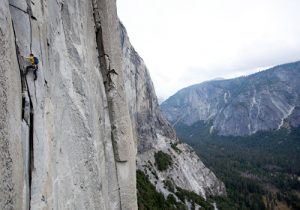 Rock climbing is an activity in which participants climb up, down or across natural rock formations or artificial rock walls. The aim is to reach the pinnacle of a formation or the endpoint of a usually pre-defined route without falling. To successfully complete a climb, one must return to the base of the route safely. Due to the length and continued tolerance required, accidents are more likely to happen on descent than ascent, especially on the larger multiple pitches (class III- IV and /or multi-day grades IV-VI climbs). Rock climbing competitions have the purpose of either completing the route in the fastest possible time or reaching the farthest point on an increasingly difficult route. Scrambling, another activity involving the scaling of hills and similar formations, is alike to rock climbing. However, rock climbing is normally distinguished by its prolonged use of hands to support the climber’s weight as well as to provide balance.
Rock climbing is an activity in which participants climb up, down or across natural rock formations or artificial rock walls. The aim is to reach the pinnacle of a formation or the endpoint of a usually pre-defined route without falling. To successfully complete a climb, one must return to the base of the route safely. Due to the length and continued tolerance required, accidents are more likely to happen on descent than ascent, especially on the larger multiple pitches (class III- IV and /or multi-day grades IV-VI climbs). Rock climbing competitions have the purpose of either completing the route in the fastest possible time or reaching the farthest point on an increasingly difficult route. Scrambling, another activity involving the scaling of hills and similar formations, is alike to rock climbing. However, rock climbing is normally distinguished by its prolonged use of hands to support the climber’s weight as well as to provide balance.
Rock climbing is a physically and mentally taxing sport, one that frequently tests a climber’s power, tolerance, agility and composure along with mental control. It can be a hazardous activity and knowledge of proper climbing techniques and usage of specialized climbing equipment is pivotal for the risk-free completion of routes. Because of the broad span and an array of rock formations around the world, rock climbing has been separated into several different styles and sub-disciplines.
Types of climbing
Most of the climbing done in current times is considered free climbing—climbing using one’s own bodily strength, with equipment used merely as protection and not as support—as averse to aid climbing, the gear-dependent form of climbing that was superior in the sport’s earlier days. Free climbing is typically divided into various styles that vary from one another depending on the choice of equipment used and the configurations of their belay, rope and anchor systems.
As routes get higher off the ground, the increased possibility of life-threatening injuries necessitate additional safety measures. A range of specialized climbing techniques and climbing equipment are met with to provide that safety. Climbers normally work in pairs and employ a system of ropes and anchors designed to catch falls. Ropes and anchors can be configured in separate ways to suit many styles of climbing, and rope climbing is thus divided into additional sub-types that differ based on how their belay systems are set up. On the whole, beginners will start with top roping and/or easy bouldering and work their way up to lead climbing and beyond.



